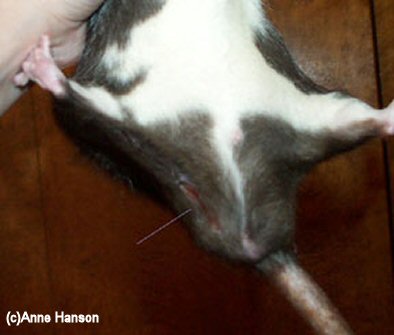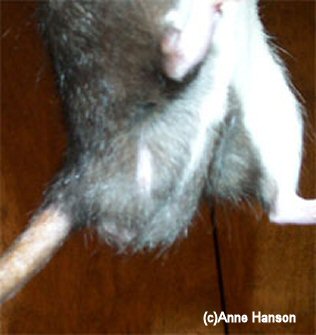Figure 1: Bite wound to the scrotum of an 11.5-month-old male rat (Cricket).
Case history and photos
History
Three male rats (presumed brothers) named Widget, Cricket and Snip were living in the same cage. One of the rats, Widget, repeatedly harassed the other two. Widget had bitten Snip twice in the past: at age 4.5 months he had bitten Snip on the rump, and at age 7 months he had bitten Snip on the side of the belly. Both wounds had healed uneventfully.
Clinical Signs
When the rats were 11.5 months old they got into a fight (I heard sounds of shrieks and crashes). Upon inspection, one of the rats, Cricket, had a one inch long gaping gash running nearly the length of
his scrotum on the right side. The edges of the wound were straight and there was little bleeding.
I cleaned the wound and separated Cricket from the others, placing him alone in an aquarium lined with clean paper towels for the night, and took him to the vet the next day.
Diagnosis
The vet said that the bite had sliced through several layers of skin but had not gone down to the testicle. The healing process had already started: the lips of the wound were stuck to the layers beneath in a semi-gaping position, and new skin cells were already making their way across the exposed layers of tissue.
Treatment
The vet said there were two options: stitch the wound shut, or leave it alone and let it heal as it was.
If the wound were sewed shut, the vet would have to disrupt the healing process that had already started. The vet would unstick the skin from the layers below, and trim the lips of the wound to give them a clean, fresh edge so they could heal together.
If there wound were left alone, the healing process would continue undisrupted. Cricket would be left with a smooth, hairless scar.
The vet advised against the stitches, because the wound was already healing nicely. Also, the vet said that scrotal skin is so sensitive that Cricket might pick at stitches, making the wound worse. The vet recommended leaving the wound alone, keeping Cricket in a clean cage for the duration of the healing process on bedding that would not contaminate the wound (such as paper towels), and putting him on antibiotics.
I took the vet’s advice. Cricket was kept in a 10 gallon aquarium for two weeks on paper towels, changed several times a day. He received 0.2mL of Trimeth/Sulpha liquid suspension twice per day, orally, for 14 days.
The vet also recommended separating and possibly neutering the rat who had inflicted the bite.
Outcome
Cricket’s wound healed uneventfully. There was no infection and Cricket did not worry the wound. New skin covered the wound, leaving an oval-shaped, smooth, hairless scar. Cricket was returned to the main cage without incident.
While Cricket was healing in the aquarium, Widget bit Snip on the knee, and in self-defense Snip bit Widget on the face, a shallow bite just below the eye. After this incident I permanently removed Widget from the main cage and housed him separately. Both bites healed uneventfully.
There have been no more bite wounds from the time of Widget’s separation.
Photos
 Photo 1: Bite wound to scrotum on day 3. |
 Photo 2: Bite wound to scrotum on day 18 shows healing. |
Case history and photos courtesy of Anne Hanson, M.S., Ph.D. Animal Behavior
http://ratbehavior.org/


